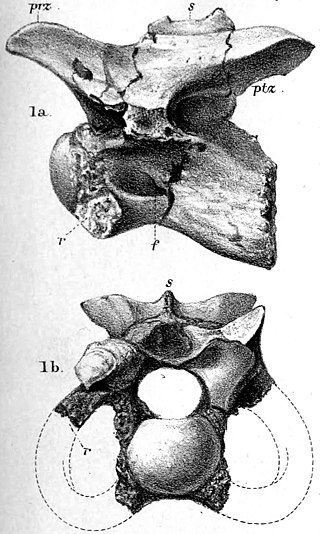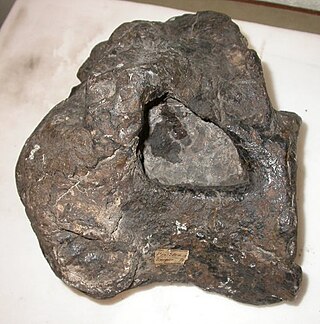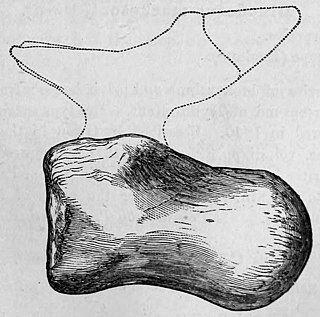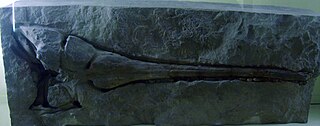Dinosaurs
- Richard Lydekker published a catalogue of reptiles in the British Museum of Natural History, their collection information, and their classification. [3]
| |||
|---|---|---|---|
| +... | |||
Paleontology or palaeontology is the study of prehistoric life forms on Earth through the examination of plant and animal fossils . [1] This includes the study of body fossils, tracks ( ichnites ), burrows , cast-off parts, fossilised feces ( coprolites ), palynomorphs and chemical residues . Because humans have encountered fossils for millennia, paleontology has a long history both before and after becoming formalized as a science . This article records significant discoveries and events related to paleontology that occurred or were published in the year 1888.
| Name | Status | Authors | Notes | |
|---|---|---|---|---|
Smets | Misidentified piece of petrified wood. [2] | |||
| Name | Status | Authors | Notes | |
|---|---|---|---|---|
| Neochen pugil | Valid | Oluf Winge | ||
| Name | Status | Authors | Location | Images | |
|---|---|---|---|---|---|
| Trinacromerum | Valid | Cragin | |||
| Name | Status | Authors | Age | Location | Images |
|---|---|---|---|---|---|
| Palaeohatteria | Valid | Credner | |||
| Phocosaurus | Valid | Seeley |
Gigantosaurus is a dubious genus of Sauropod dinosaur from the Late Jurassic Kimmeridge Clay Formation of England. The type species, Gigantosaurus megalonyx, was named and described by Harry Govier Seeley in 1869.

Richard Lydekker was an English naturalist, geologist and writer of numerous books on natural history.
Liopleurodon is an extinct genus of carnivorous pliosaurid pliosaurs that lived from the Callovian stage of the Middle Jurassic to the Kimmeridgian stage of the Late Jurassic period. The type species is L. ferox, which is probably the only valid species. Some studies also include the second species L. pachydeirus, but this latter is considered as a probable junior synonym of L. ferox due to its lack of viable diagnosis. As the holotype specimen of L. ferox consists of a single tooth preserving questionable distinctive features, recent studies therefore recommend the necessary identification of a neotype in order to preserve the validity of the genus. Numerous fossil specimens attributed to Liopleurodon, even including numerous skeletons, have been discovered in Europe, Russia, and Mexico. Other additional species were even proposed, but these are currently seen as coming from other pliosaurid genera.
Coelurus is a genus of coelurosaurian dinosaur from the Late Jurassic period. The name means "hollow tail", referring to its hollow tail vertebrae. Although its name is linked to one of the main divisions of theropods (Coelurosauria), it has historically been poorly understood, and sometimes confused with its better-known contemporary Ornitholestes. Like many dinosaurs studied in the early years of paleontology, it has had a confusing taxonomic history, with several species being named and later transferred to other genera or abandoned. Only one species is currently recognized as valid: the type species, C. fragilis, described by Othniel Charles Marsh in 1879. It is known from one partial skeleton found in the Morrison Formation of Wyoming, United States. It was a small bipedal carnivore with elongate legs.
Calamospondylus is a genus of theropod dinosaur. It lived during the Early Cretaceous and its fossils were found on the Isle of Wight in southern England. The type species is C. oweni.

Calamosaurus was a genus of small theropod dinosaur from the Barremian-age Lower Cretaceous Wessex Formation of the Isle of Wight, England. It is based on two cervical vertebrae, collected by Reverend William Fox.

Valdoraptor is a genus of theropod dinosaur from the Early Cretaceous. Its fossils were found in England. It is known only from bones of the feet. The holotype, BMNH R2559, was found near Cuckfield in layers of the Tunbridge Wells Sand Formation dating from the late Valanginian. The specimen is damaged lacking parts of the upper and lower ends. It has a conserved length of 215 millimetres (8.5 in) and an estimated length of 240 millimetres (9.4 in). This genus is paleontologically significant for being the first ornithomimosaur specimen known from England and represents the earliest record of ornithomimosaurs.

Ornithopsis is a genus of sauropod dinosaur, from the Early Cretaceous of England and possibly Germany. The type species, which is the only species seen as valid today, is O. hulkei, which is only known from fragmentary remains.

Iuticosaurus is a genus of titanosaur sauropod dinosaur from the Early Cretaceous of the Isle of Wight. Two species have been named: I. valdensis and I. lydekkeri. I. valdensis was found in the Wessex Formation and I. lydekkeri in the younger Upper Greensand.

Cetiosauridae is a family of sauropod dinosaurs which was first proposed by Richard Lydekker in 1888. While traditionally a wastebasket taxon containing various unrelated species, some recent studies have found that it may represent a natural clade. Alongside Cetiosaurus from the Middle Jurassic of Britain, other taxa recently assigned to the family include Lapparentosaurus from the Middle Jurassic of Madagascar, and Patagosaurus from the late Early-Middle Jurassic of Patagonia, which share autapomorphies with Cetiosaurus that are not shared by other eusauropods. Additionally, at least one study has suggested that the mamenchisaurids may represent a sub-group of the cetiosaurids, which would be termed Mamenchisaurinae.

Cretornis is a pterosaur genus from the late Cretaceous period of what is now the Jizera Formation in the Czech Republic, dating to about 92 million years ago. It only contains a single species, Cretornis hlavaci.
"Palaeornis" cliftii is a pterosaur species known from parts of a single humerus found in the early Cretaceous (Valanginian) of the upper Tunbridge Wells Sand Formation, England.
Syllomus is an extinct genus of sea turtle from the Miocene-age deposits in the US Eastern Seaboard and Egypt.

Cimoliasaurus was a plesiosaur that lived during the Late Cretaceous (Maastrichtian) of the eastern United States, with fossils known from New Jersey, North Carolina, and Maryland.

Crymocetus is an extinct genus of Reptilia from the Late Cretaceous Chalk Group of Sussex, England. It is only known from the type species, which is C. bernardi.
Paleontology or palaeontology is the study of prehistoric life forms on Earth through the examination of plant and animal fossils. This includes the study of body fossils, tracks (ichnites), burrows, cast-off parts, fossilised feces (coprolites), palynomorphs and chemical residues. Because humans have encountered fossils for millennia, paleontology has a long history both before and after becoming formalized as a science. This article records significant discoveries and events related to paleontology that occurred or were published in the year 1890.

Kentisuchus is an extinct genus of gavialoid crocodylian, traditionally regarded as a member of the subfamily Tomistominae. Fossils have been found from England and France that date back to the early Eocene. The genus has also been recorded from Ukraine, but it unclear whether specimens from Ukraine are referable to Kentisuchus.

Pholidosaurus is an extinct genus of neosuchian crocodylomorph. It is the type genus of the family Pholidosauridae. Fossils have been found in northwestern Germany. The genus is known to have existed during the Berriasian-Albian stages of the Early Cretaceous. Fossil material found from the Annero and Jydegård Formations in Skåne, Sweden and on the island of Bornholm, Denmark, have been referred to as a mesoeucrocodylian, and possibly represent the genus Pholidosaurus.

Klobiodon is a genus of rhamphorhynchid pterosaur from the Middle Jurassic Taynton Limestone Formation of Oxfordshire, England.